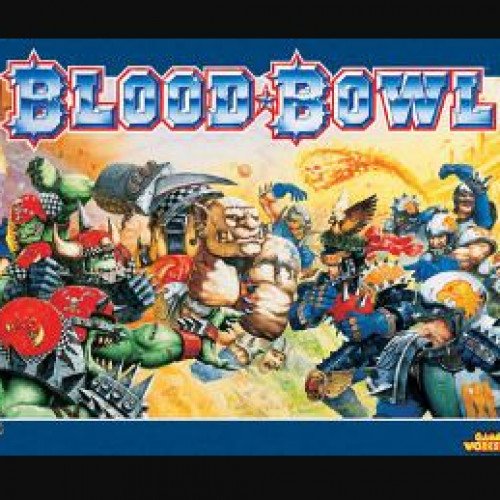BLOOD BOWL VS CAMELOT

BLOOD BOWL
Blood Bowl is a fantasy football game created by Jervis Johnson for the British games company Games Workshop as a parody of American Football. The game was first released in 1986 and has been re-released in new editions since. Blood Bowl is set in an alternate version of the Warhammer Fantasy setting, populated by traditional fantasy elements such as human warriors, goblins, dwarves, elves, orcs and trolls. In late 2016, Games Workshop released a new version of the game - the first in 22 years. It featured a double sided board and new plastic miniatures. In August 2020, Games Workshop announced the latest version of the game, titled Blood Bowl Second Season Edition, which features a significant overhaul of the rules. This version was released in November 2020 and included miniatures for two teams and referees, a board (pitch), templates and the rule book. The rule book was also available separately, both physically and digitally. Cyanide Studio confirmed that the next videogame adaptation, Blood Bowl 3, would use the new ruleset. Blood Bowl is a two-player, turn-based board game that typically uses 28 mm miniatures to represent a contest between two teams on a playing field. A board containing a grid overlay represents the field. Using dice, cards, and counters, the players attempt to score higher than each other by entering the opponent's end zone with a player who possesses the ball. The "Blood" in Blood Bowl is represented by the violent actions available to players. Game play is based on a hybrid of American Football and Rugby. Players may attempt to injure or maim the opposition in order to make scoring easier by reducing the number of enemy players on the field.
Statistics for this Xoptio

CAMELOT
Camelot is a strategy board game for two players. It was invented by George S. Parker late in the 19th century, and was one of the first games published by Parker Brothers, originally under the name Chivalry. The game was reissued as "Camelot" in 1930, with reduced size and number of pieces. It flourished through numerous editions and variants, achieving its greatest popularity in the 1930s, and remained in print through the late 1960s. Parker Brothers briefly republished the game in the 1980s under the name Inside Moves. Since then it has been out of print, but retains a core of fans anticipating another revival. Camelot is easy to learn and without extensive theory or praxis, making it perhaps more accessible for novices to play/enjoy compared to chess. Gameplay is exceptionally tactical almost from the first move, so games are quick to play to a finish. A World Camelot Federation exists, with free membership, led by Michael W. Nolan. Camelot was featured in Abstract Games magazine in 2001 and 2002. In 1882, George S. Parker began working on an abstract board game called Chivalry. His goal was to create a game not so difficult as chess, but considerably more varied than checkers. Parker created a game that was a complex, tactical, but an easily learned and quickly played mixture of Halma and checkers. When finally published by Geo. S. Parker & Co. in 1887, Chivalry won the raves of chess and checkers experts, but the game Parker called "the best game in 2000 years" did not catch on quickly with the general public. However, Parker never lost his enthusiasm for the game, and in 1930 he made a few changes, and Parker Brothers republished it under the name "Camelot". A few more rules changes followed in 1931. Camelot enjoyed its greatest popularity in the 1930s. Camelot players included José Raúl Capablanca, World Chess Champion from 1921 to 1927, and Frank Marshall, U.S. Chess Champion from 1907 to 1936. Sidney Lenz and Milton Work, two world-famous bridge players, also played the game. There were over 50 different editions of Camelot sets issued, including a gold-stamped leather edition and a mahogany cabinet edition. There were tournament editions, regular editions, and low-cost editions. Camelot was eventually discontinued in 1968, then reissued as "Inside Moves" in 1985, and finally discontinued again in 1986.